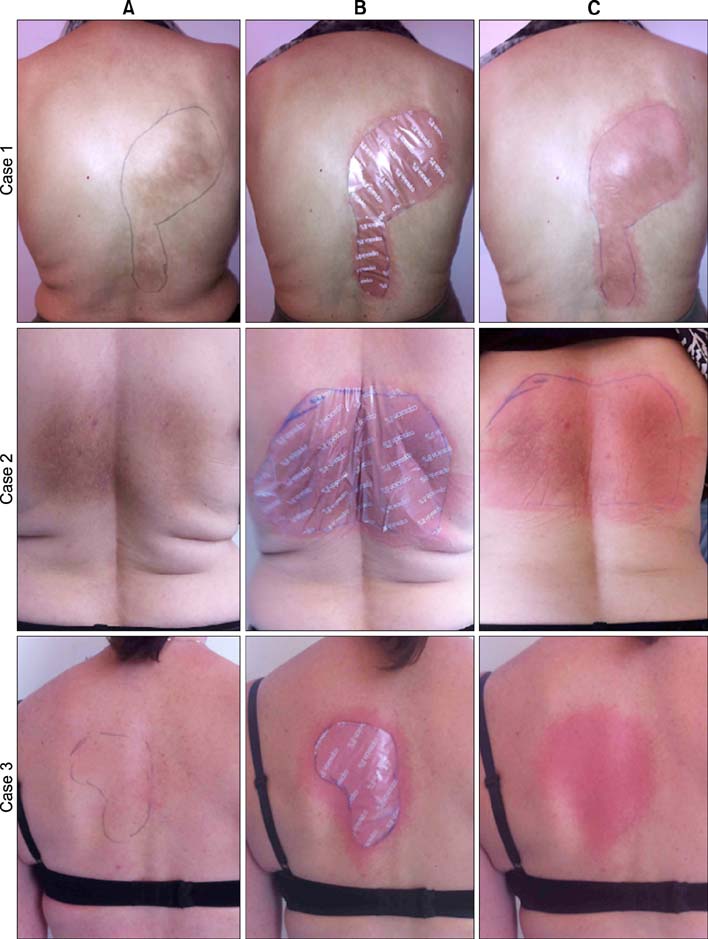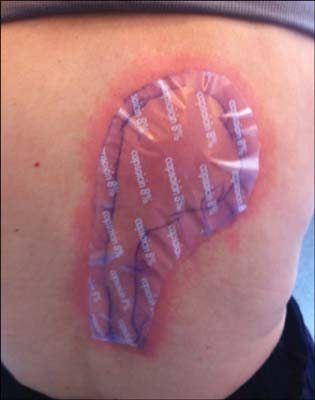Ann Dermatol.
2016 Feb;28(1):86-89. 10.5021/ad.2016.28.1.86.
Considerable Variability in the Efficacy of 8% Capsaicin Topical Patches in the Treatment of Chronic Pruritus in 3 Patients with Notalgia Paresthetica
- Affiliations
-
- 1Center of Sensory-Motor Interaction, Department of Health Science and Technology, Faculty of Medicine, Aalborg University, Aalborg, Denmark.
- 2Dermato-venerological Department, Bispebjerg Hospital, Copenhagen, Denmark.
- 3The Allergy Clinic, Copenhagen University Hospital Gentofte, Gentofte, Denmark. jelberling@ dadlnet.dk
- KMID: 2429486
- DOI: http://doi.org/10.5021/ad.2016.28.1.86
Abstract
- Notalgia paresthetica (NP) is a focal neuropathic itch condition manifesting in intense chronic or recurrent episodic itch in a hyperpigmented, macular, uni- or bilateral skin area located below and/or medially to the scapulae. Achieving satisfactory relieve in NP patients is challenging. In this case-series three female NP patients were treated with 8% capsaicin patches following a spatial quantification of their alloknetic area with a von Frey filament. The use of a von Frey filament in order to delimit the precise area of itch sensitization and thus patch application, proved clinically feasible. Although 8% topical capsaicin relieved itch in all three patients, the duration of the effectiveness varied greatly from only 3 days to >2 months. The treatment was well tolerated in the patients and there appear to be no significant hindrances to applying this treatment with NP as an indication, although it may only exhibit satisfactory effectiveness in certain patients. Placebo-controlled double-blinded trials are needed to confirm the effectiveness of the treatment and assess predictive parameters of the treatment outcome.
Keyword
Figure
Reference
-
1. Huesmann T, Cunha PR, Osada N, Huesmann M, Zanelato TP, Phan NQ, et al. Notalgia paraesthetica: a descriptive two-cohort study of 65 patients from Brazil and Germany. Acta Derm Venereol. 2012; 92:535–540.
Article2. Ständer S, Weisshaar E, Mettang T, Szepietowski JC, Carstens E, Ikoma A, et al. Clinical classification of itch: a position paper of the International Forum for the Study of Itch. Acta Derm Venereol. 2007; 87:291–294.
Article3. Alai NN, Skinner HB, Nabili ST, Jeffes E, Shahrokni S, Saemi AM. Notalgia paresthetica associated with cervical spinal stenosis and cervicothoracic disk disease at C4 through C7. Cutis. 2010; 85:77–81.4. Loosemore MP, Bordeaux JS, Bernhard JD. Gabapentin treatment for notalgia paresthetica, a common isolated peripheral sensory neuropathy. J Eur Acad Dermatol Venereol. 2007; 21:1440–1441.
Article5. Savk E, Bolukbasi O, Akyol A, Karaman G. Open pilot study on oxcarbazepine for the treatment of notalgia paresthetica. J Am Acad Dermatol. 2001; 45:630–632.
Article6. Savk E, Savk O, Sendur F. Transcutaneous electrical nerve stimulation offers partial relief in notalgia paresthetica patients with a relevant spinal pathology. J Dermatol. 2007; 34:315–319.
Article7. Weinfeld PK. Successful treatment of notalgia paresthetica with botulinum toxin type A. Arch Dermatol. 2007; 143:980–982.
Article8. Maari C, Marchessault P, Bissonnette R. Treatment of notalgia paresthetica with botulinum toxin A: a doubleblind randomized controlled trial. J Am Acad Dermatol. 2014; 70:1139–1141.
Article9. Metz M, Krause K, Maurer M, Magerl M. Treatment of notalgia paraesthetica with an 8% capsaicin patch. Br J Dermatol. 2011; 165:1359–1361.
Article10. O'Neill J, Brock C, Olesen AE, Andresen T, Nilsson M, Dickenson AH. Unravelling the mystery of capsaicin: a tool to understand and treat pain. Pharmacol Rev. 2012; 64:939–971.11. Uçeyler N, Sommer C. High-dose capsaicin for the treatment of neuropathic pain: what we know and what we need to know. Pain Ther. 2014; 3:73–84.
Article12. Andersen HH, Elberling J, Arendt-Nielsen L. Human Surrogate Models of Histaminergic and Non-histaminergic Itch. Acta Derm Venereol. 2015; 95:771–777.
Article13. Højland CR, Andersen HH, Poulsen JN, Arendt-Nielsen L, Gazerani P. A Human Surrogate Model of Itch Utilizing the TRPA1 Agonist Trans-cinnamaldehyde. Acta Derm Venereol. 2015; 95:798–803.
Article14. Misery L, Brenaut E, Le Garrec R, Abasq C, Genestet S, Marcorelles P, et al. Neuropathic pruritus. Nat Rev Neurol. 2014; 10:408–416.
Article15. Raber JM, Reichelt D, Grüneberg-Oelker U, Philipp K, Stubbe-Dräger B, Husstedt IW. Capsaicin 8% as a cutaneous patch (Qutenza™): analgesic effect on patients with peripheral neuropathic pain. Acta Neurol Belg. 2015; 115:335–343.
Article
- Full Text Links
- Actions
-
Cited
- CITED
-
- Close
- Share
- Similar articles
-
- Neuropathic Itch of the Back: A Case of Notalgia Paresthetica
- Effect of Topical Capsaicin in Chronic Low Back and Posterior Neck Pain
- Notalgia Paresthetica of the Back Successfully Controlled by Pregabalin
- Clinical Study of ZalsmingR on Xerosis and Pruritus
- The Effect of Topical Application of Capsaicin on the Flap Survival



